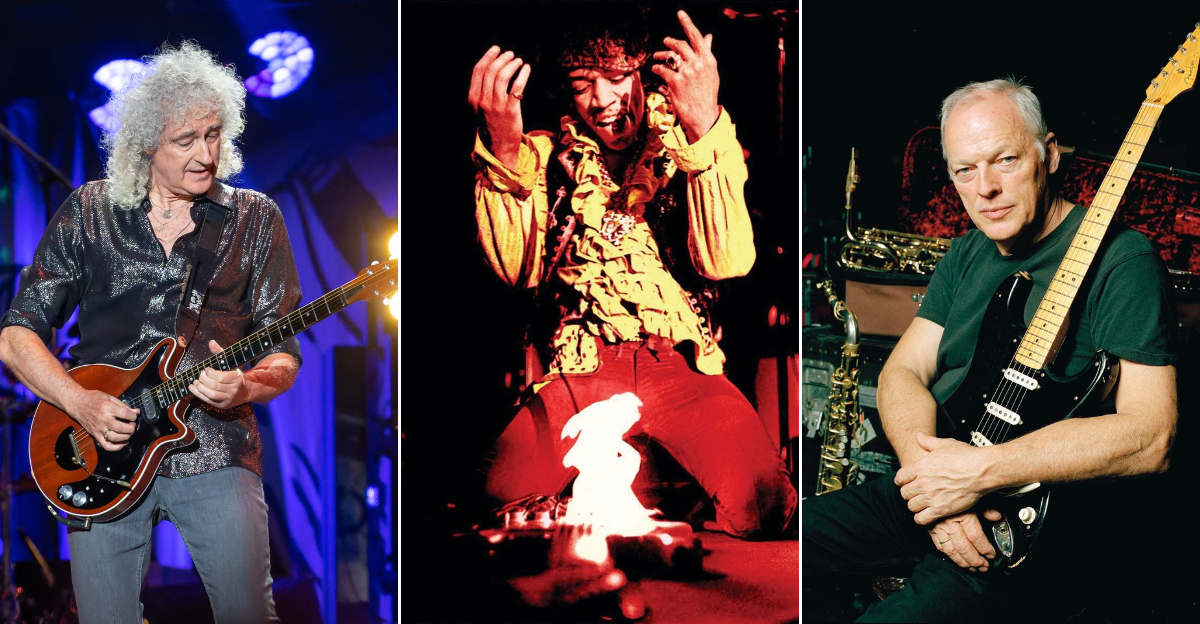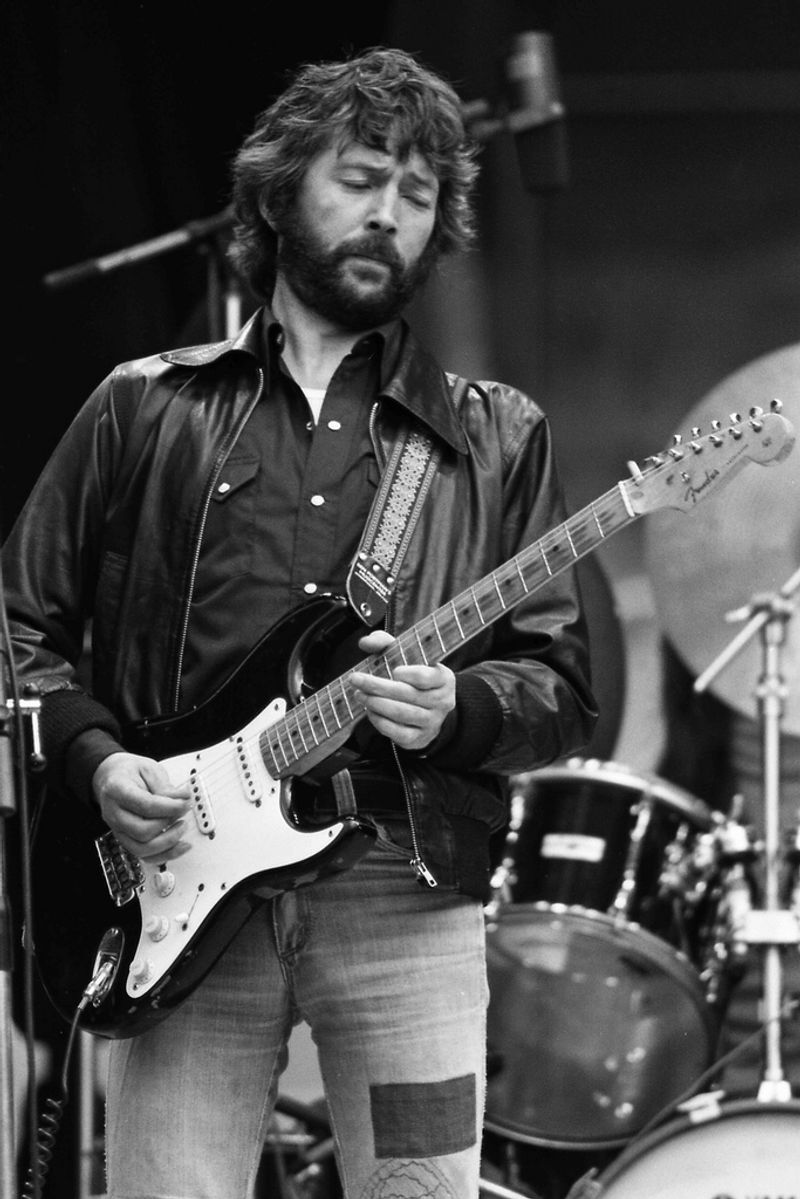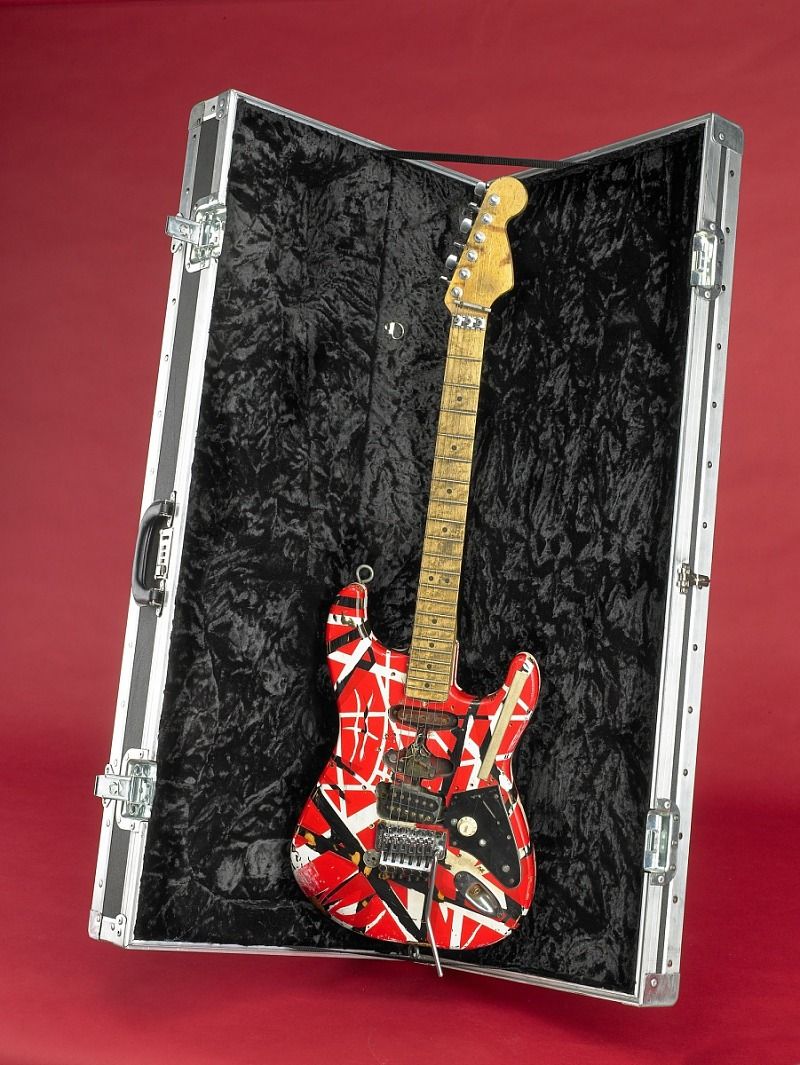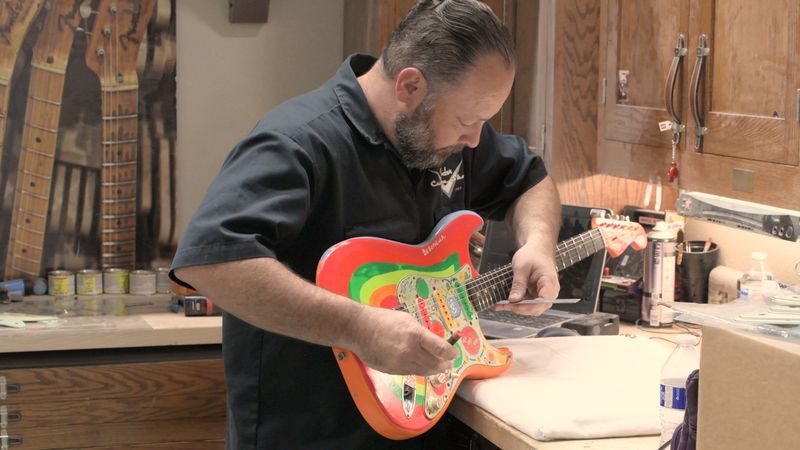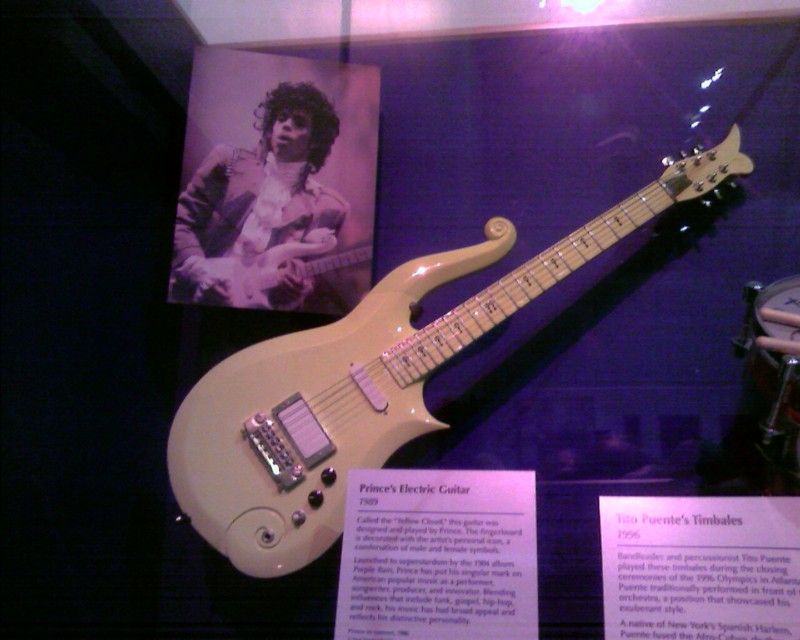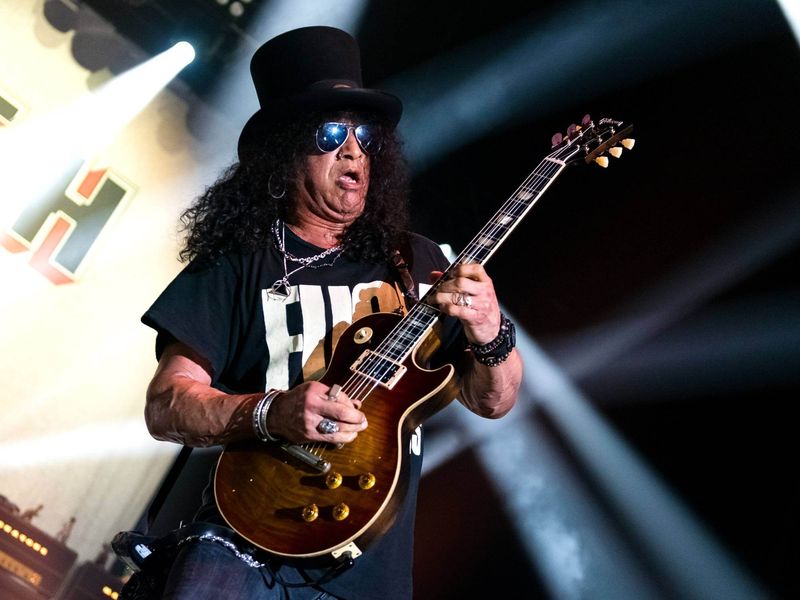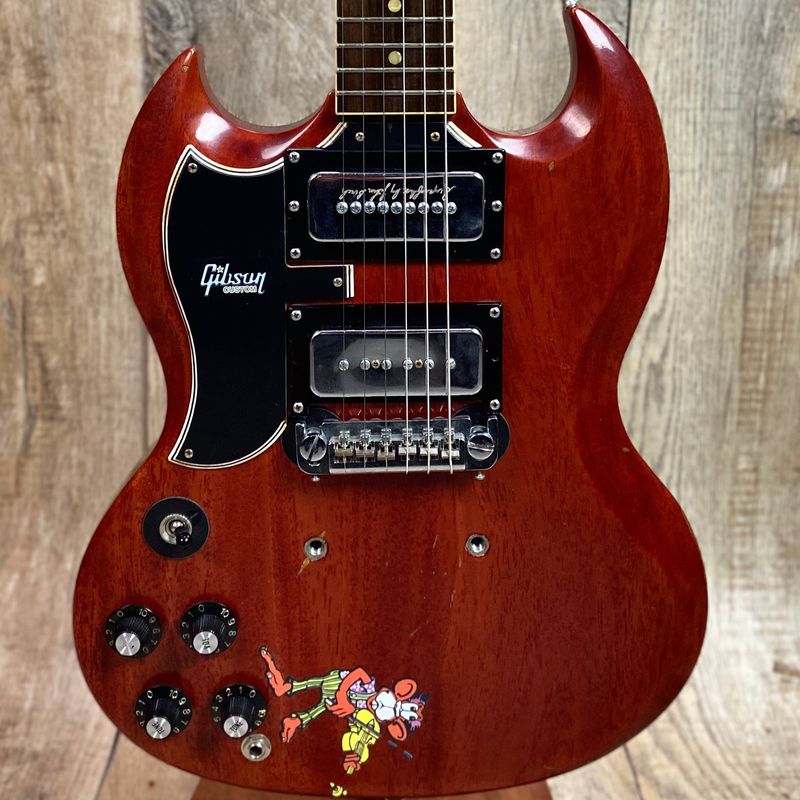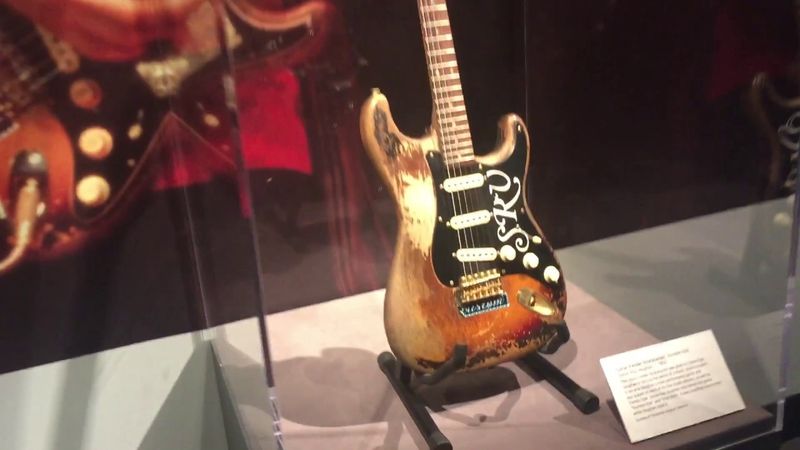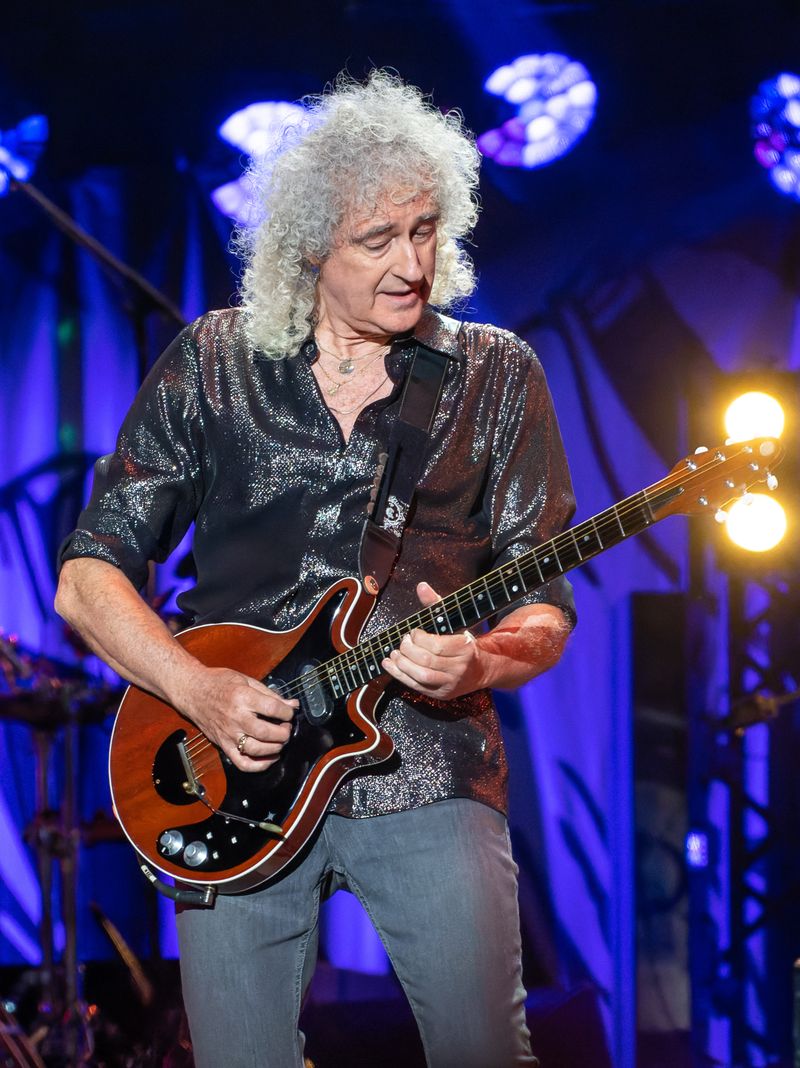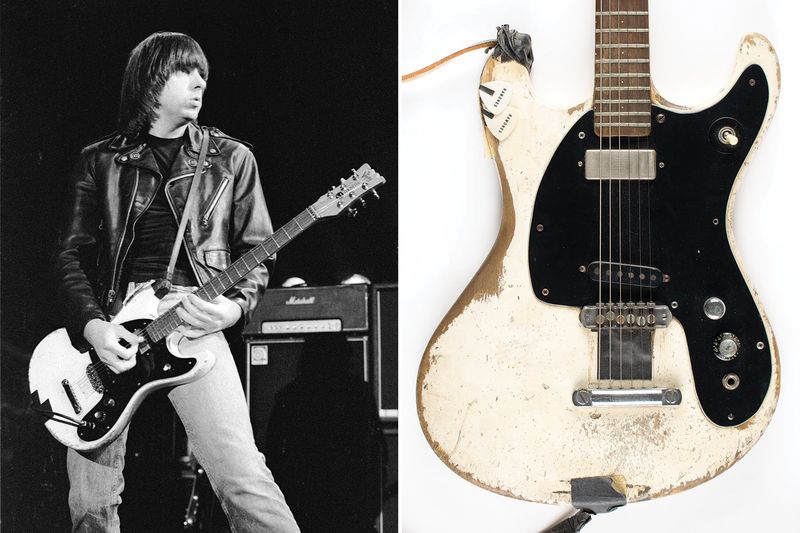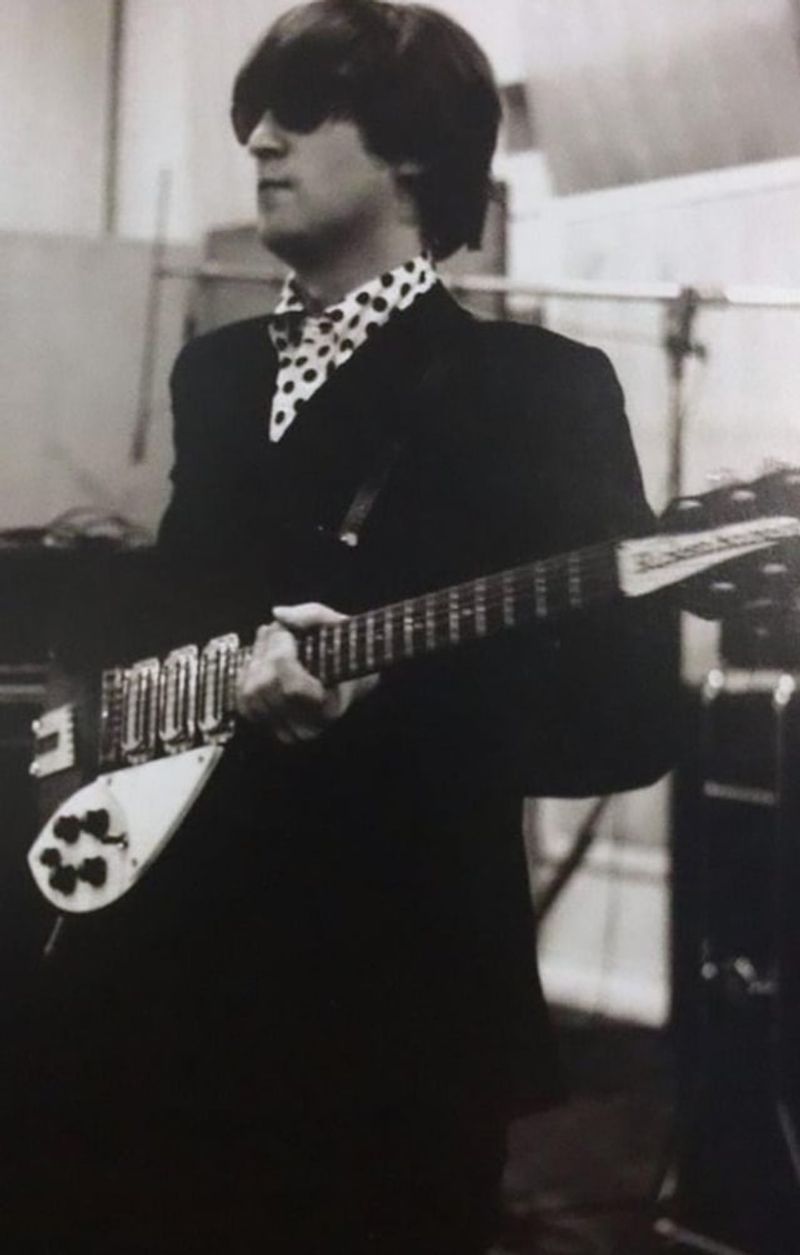These aren’t just instruments—they’re legends in wood and wire. These guitars helped shape the sound of rock ’n’ roll, carried iconic solos, and in some cases, became just as famous as the artists who played them. From Hendrix’s scorched Strat to Prince’s purple axe, each guitar on this list has a story that helped define music history.
1. B.B. King’s “Lucille”
The story of B.B. King’s ‘Lucille’ is as soulful as the blues itself. In a dramatic turn of events, King rescued his guitar from a burning dance hall, naming it ‘Lucille’ as a reminder to avoid fighting over women. This Gibson became his constant companion, helping King express his deepest emotions through music.
With its rich tone and King’s virtuosic playing, ‘Lucille’ became synonymous with the blues. Beyond its musical significance, Lucille stood as a symbol of resilience and passion, embodying the essence of King’s illustrious career that spanned decades.
2. Jimmy Page’s “Number One” Gibson Les Paul
In 1969, Jimmy Page acquired a 1959 Gibson Les Paul Standard that would become legendary. Dubbed ‘Number One,’ this guitar was Page’s go-to for Led Zeppelin’s iconic recordings, including ‘Whole Lotta Love.’ Its powerful sound and Page’s mastery created unforgettable riffs that defined an era.
‘Number One’ wasn’t just an instrument; it was an extension of Page himself, channeling his creativity and innovation. With its distinctive tone, this guitar became a staple in rock history, contributing to Zeppelin’s electrifying stage presence and groundbreaking albums.
3. Eric Clapton’s “Blackie”
‘Blackie’ emerged from Clapton’s vision, crafted from parts of three vintage Strats. This iconic guitar became his signature throughout the ’70s and ’80s, delivering timeless performances.
The sleek black finish and distinctive tone made ‘Blackie’ a standout. Clapton’s emotive playing resonated with audiences, and in 2004, ‘Blackie’ fetched nearly $1 million at auction, underscoring its legendary status.
More than an instrument, ‘Blackie’ represented Clapton’s musical journey and influence on blues rock, becoming a symbol of his unparalleled artistry and contribution to music history.
4. Jimi Hendrix’s Monterey Fender Stratocaster
Hendrix’s 1967 performance at the Monterey Pop Festival was nothing short of legendary. With a bold move, he set his white Fender Stratocaster ablaze, captivating the audience and forever etching this moment in rock history. This act was more than just spectacle; it symbolized a rebellion and the fiery spirit of rock’s emergence.
Hendrix’s unique style and unmatched charisma turned this guitar into an icon, representing the counterculture movement of the 1960s. This moment remains a defining image of rock ‘n’ roll, marking Hendrix as a trailblazer who forever changed the music scene.
5. Kurt Cobain’s Fender Mustang
Kurt Cobain’s Fender Mustang epitomized the grunge movement of the early ’90s. Known for its offset body and gritty sound, this guitar defined Nirvana’s raw aesthetic. Cobain famously wielded it in the iconic ‘Smells Like Teen Spirit’ video, a visual and auditory anthem of grunge.
This unassuming guitar became a symbol of Cobain’s influence and the era’s cultural shift. Its distinct tone and Cobain’s emotive style resonated with a generation, marking the Mustang as a pivotal instrument in rock history.
6. Eddie Van Halen’s “Frankenstrat”
Eddie Van Halen revolutionized guitar design with his ‘Frankenstrat,’ a custom creation merging Gibson’s sound with Fender’s feel. This red-and-white-striped guitar became synonymous with Van Halen’s groundbreaking style.
Built from various parts, the Frankenstrat allowed Van Halen to push musical boundaries, displaying unparalleled technical prowess. Its unique look and sound inspired countless guitarists, cementing Van Halen’s legacy as a true innovator in rock music.
This guitar wasn’t just an instrument; it was a statement of creativity and individuality, forever changing the landscape of rock.
7. George Harrison’s “Rocky” Fender Stratocaster
George Harrison’s ‘Rocky’ Stratocaster stands as a vibrant symbol of the psychedelic ’60s. Hand-painted by Harrison himself, this guitar added a kaleidoscope of colors to The Beatles’ creative era.
Played during the recording of ‘Sgt. Pepper’s Lonely Hearts Club Band’ and ‘All You Need Is Love,’ ‘Rocky’ became an emblem of peace and creativity. Its colorful design and rich history reflect Harrison’s artistic spirit and contribution to music.
This guitar wasn’t just played; it was a visual and auditory expression of an era’s optimism and innovation.
8. Chuck Berry’s Gibson ES-350T
Chuck Berry’s Gibson ES-350T wasn’t just a guitar; it was a revolution. With it, Berry laid the foundation of rock guitar, merging rhythm and blues into a new sound.
Famous for his energetic performances and signature duckwalk, Berry’s ES-350T became a rock and roll icon. Its rich, resonant tone made tracks like ‘Johnny B. Goode’ unforgettable.
This guitar symbolized the raw energy and spirit of rock’s birth, marking Berry as a pioneer who inspired generations of musicians and listeners alike.
9. Bo Diddley’s Rectangular Guitar
Bo Diddley’s custom rectangular guitar broke the mold of traditional designs. Frustrated with conventional shapes, Diddley crafted this distinctive instrument, making it a signature part of his image.
Its unconventional look matched Diddley’s innovative style, influencing future generations. Known for its rhythmic drive, this guitar contributed to the evolution of rock music.
Diddley’s creation wasn’t just about aesthetics; it showcased his bold personality and desire to push boundaries, making a lasting impact on music and culture.
10. Prince’s “Cloud” Guitar
Prince’s ‘Cloud’ guitar, with its unique curves and custom design, became an iconic symbol of his musical genius. Designed in the early ’80s, this guitar was a staple in Prince’s performances, especially during ‘Purple Rain.’
The ‘Cloud’ wasn’t just about looks; its distinctive sound mirrored Prince’s innovative approach to music. This guitar was an extension of his flamboyant persona and artistic vision.
With its memorable shape and sound, the ‘Cloud’ guitar contributed to Prince’s legendary status, embodying his creativity and impact on pop and rock music.
11. Slash’s Gibson Les Paul (Replica)
Though often mistaken for a vintage Les Paul, Slash’s main guitar was a replica crafted by luthier Kris Derrig. This guitar powered the iconic riffs of Guns N’ Roses’ ‘Appetite for Destruction,’ with its unmistakable tone and Slash’s fiery playing.
The replica Les Paul was more than an instrument; it was part of Slash’s identity, symbolizing the gritty, rebellious spirit of rock in the late ’80s. Its searing sound became synonymous with his electrifying solos and stage presence.
12. Tony Iommi’s Red “Monkey” SG
Tony Iommi’s Red ‘Monkey’ SG became synonymous with the birth of heavy metal. After a factory accident, he customized this guitar to accommodate prosthetic fingers, creating the powerful sound of Black Sabbath.
The ‘Monkey’ SG’s heavy tones and Iommi’s innovative playing style defined songs like ‘Paranoid’ and ‘Iron Man.’ This guitar wasn’t just an instrument; it was a testament to resilience and creativity, shaping the genre of heavy metal.
Iommi’s adaptation turned a challenge into a revolution, inspiring countless musicians with its story and sound.
13. Stevie Ray Vaughan’s “Number One” Strat
Worn but revered, Stevie Ray Vaughan’s ‘Number One’ Stratocaster was more than a guitar—it was a blues machine. With broken necks and sweat-soaked gigs, this guitar endured countless performances.
Its distinctive tone helped reignite the blues in the ’80s, with Vaughan’s incendiary playing captivating audiences worldwide. ‘Number One’ became an iconic symbol of Vaughan’s talent and passion, marking his indelible impact on the music scene.
This Strat wasn’t just played; it was lived with, embodying Vaughan’s spirit and the raw power of the blues.
14. Brian May’s “Red Special”
Built with his father from household scraps, Brian May’s ‘Red Special’ is a testament to ingenuity. This custom guitar, crafted from a fireplace mantle, gave Queen its signature operatic guitar tone.
The ‘Red Special’ wasn’t just an instrument; it was part of May’s identity, reflecting his commitment to creativity and precision. Its unique sound and history set it apart, contributing to Queen’s legendary status.
May’s innovation and craftsmanship turned the ‘Red Special’ into a symbol of individuality and musical excellence, inspiring generations of musicians.
15. David Gilmour’s “Black Strat”
David Gilmour’s ‘Black Strat’ became a cornerstone of Pink Floyd’s sound. Used on ‘The Dark Side of the Moon’ and ‘The Wall,’ this guitar was Gilmour’s main studio and stage instrument for decades.
Its rich, atmospheric tones complemented Pink Floyd’s progressive style, with Gilmour’s emotive playing marking unforgettable solos. The ‘Black Strat’ wasn’t just a guitar; it was a vehicle for Gilmour’s creativity, defining an era of music.
This instrument stands as a symbol of innovation and artistry, contributing to the band’s enduring legacy.
16. Randy Rhoads’ Polka Dot Flying V
Randy Rhoads’ polka dot Flying V was as flashy as his playing style. This custom-built guitar became synonymous with Rhoads’s work with Ozzy Osbourne, matching his classically-inspired metal wizardry.
The guitar’s bold design and Rhoads’s innovative techniques left an indelible mark on metal music. It wasn’t just an instrument; it was an extension of Rhoads’s creative spirit, influencing countless guitarists.
Rhoads’s Flying V symbolized the fusion of classical and metal, pushing the boundaries of the genre and inspiring a legacy of innovation.
17. Tom Morello’s “Arm the Homeless” Guitar
Tom Morello’s ‘Arm the Homeless’ guitar is a testament to musical experimentation. Customized beyond recognition, this guitar powered Morello’s unique sound with Rage Against the Machine.
Its graffiti-covered body reflected Morello’s activist spirit, while its unconventional modifications enabled sonic innovation. Morello’s playing style, characterized by unorthodox techniques, broke new ground in rock music.
The ‘Arm the Homeless’ guitar wasn’t just an instrument; it was a voice for change, embodying Morello’s commitment to pushing musical and social boundaries.
18. Johnny Ramone’s Mosrite Ventures II
Johnny Ramone’s Mosrite Ventures II was as minimalist as punk itself. This guitar helped define the rapid-fire, downstroke-heavy sound that characterized punk rock.
Ramone’s straightforward playing style and the Mosrite’s distinct tone became the backbone of The Ramones’ music, resonating with fans worldwide. This guitar wasn’t just about sound; it was about attitude, embodying the rebellious spirit of punk.
With its lean design and powerful presence, the Mosrite Ventures II became a symbol of punk’s raw energy and influence.
19. John Lennon’s Rickenbacker 325
John Lennon’s Rickenbacker 325 played a crucial role in The Beatles’ early sound. This short-scale guitar, wielded by Lennon during their legendary Ed Sullivan Show appearance in 1964, became an icon of the British Invasion.
Its jangly tone and Lennon’s rhythmic style created a new musical wave, capturing the hearts of millions. The Rickenbacker 325 wasn’t just a guitar; it was a symbol of a cultural phenomenon.
This instrument marked the beginning of Beatlemania, contributing to the band’s revolutionary impact on music and culture.
20. Neil Young’s “Old Black” Les Paul
Neil Young’s ‘Old Black’ Les Paul is a testament to constant evolution. Over decades, Young modified this guitar, helping define his raw, distorted tone.
With its unique sound, ‘Old Black’ played a pivotal role in tracks like ‘Cortez the Killer,’ showcasing Young’s dynamic style. This guitar wasn’t just an instrument; it was a canvas for Young’s creativity.
‘Old Black’ became synonymous with Young’s artistic journey, reflecting his relentless pursuit of musical exploration and innovation.
21. Billy Gibbons’s “Pearly Gates” Les Paul
Billy Gibbons’s ‘Pearly Gates’ Les Paul is as legendary as its tones. Named after a car that supposedly ‘delivered’ ZZ Top’s breakout sound, this guitar defined Texas blues-rock.
Its searing tone and Gibbons’s masterful playing created unforgettable riffs, contributing to ZZ Top’s signature sound. ‘Pearly Gates’ wasn’t just an instrument; it was part of Gibbons’s persona, reflecting his deep connection to music.
With its rich history and unique sound, ‘Pearly Gates’ remains a symbol of Gibbons’s influence and the power of rock and blues.
22. Jack White’s Airline Res-O-Glas
Jack White’s Airline Res-O-Glas is as striking as it is challenging. Made of fiberglass and notoriously difficult to play, this bright red guitar matched White’s raw blues aesthetic.
Its unconventional build and White’s innovative style led The White Stripes’ distinctive sound, pushing the boundaries of modern rock. This guitar wasn’t just about appearance; it was about embracing uniqueness and creativity.
The Res-O-Glas remains a testament to White’s artistic vision, inspiring musicians to break norms and redefine rock music.
